Panel: Women Blazing the Trail for National Defense Are Doing So Together
They each had different backgrounds, different dreams, different heroes. Four leading women in the U.S. Defense Department gathered Wednesday and shared a unified message: You can have it all; you just can't do it alone.
Lt. Gen. VeraLinn “Dash” Jamieson, USAF, is thankful that her ears bleed in unpressurized aircraft cabins.
She might not otherwise have become an intelligence officer, and now the deputy chief of staff for intelligence, surveillance and reconnaissance and the Air Force’s senior intelligence officer.
She entered the Air Force through the ROTC program at West Virginia University, and was awestruck by motivational leaders who helped her develop a yearning to become a pilot.
But her ears bled.
That almost guaranteed an end to her military career, until she proved herself valuable and a senior officer convinced her to seek a path in intelligence, where she would tell pilots where the threats were and help save their lives, Gen. Jamieson shared Wednesday at an AFCEA DC Chapter monthly breakfast honoring women who play critical roles in national defense.
And so, it was in June 1986 that she landed at Suwon Air Base in South Korea, where she lived as the only female officer on the base for a year. She developed a close friendship another newbie who became her "wingman." Capt. Steven Phillis, USAF, would accompany her to the hairdresser or go shopping—albeit reluctantly—she quipped. They remained friends for years. One day during the Gulf War, Phillis set out to fly a search and rescue mission. He never landed. He’d been shot down, she shared, because intelligence did not tell him about the threat.
“That’s probably why I’m here,” she shared. “I didn’t want someone else to lose somebody because the intelligence didn’t get to the pilot. It was not my dream at the time, but it is my passion now.”
Today, she works as closely as possible with the service's chief of operations to ensure airmen get the precise intelligence, surveillance and reconnaissance they need to carry out missions—and make it back alive, said Gen. Jamieson, flanked on the stage Wednesday by a panel of influential women from the Defense Department who appeared as taken by her story as the audience.
Each woman has blazed varying new trails to get where they are today: Lynn Wright, deputy director of Naval Intelligence, who started her government career as a GS-5 earning roughly $13,000 a year—which paid a lot more than her bartending gig; Brig. Gen. Patricia Frost, USA, director of Cyber for the Office of the Deputy Chief of Staff, Army G-3/5/7, who majored in political science and Italian before entering the world of information technology; and Barbara Hoffman, principal director for the deputy chief information officer for Information Enterprise at the Defense Department, who once helped out male colleagues on loading docks receive trailers of supplies.
Each challenge and experience made them the leaders they are today—challenges that persist as they navigate the dynamic national defense environment, the panelists shared.
Gen. Frost leads the Army's fairly new directorate to oversee cybersecurity and electronic warfare. “When you’re trying to … create a new staff element, that brings a lot of friction,” she said. “Right now, my biggest concern is ‘do I have enough time to establish this directorate that is going to be enduring?’” she asked. “It is so critical. We have to integrate cyber, electronic warfare and information operations. And I have big aspirations—I’d like to pull space over. I can see where we’re headed.”
She seeks to quell the uncertainties that arise during the cultural change of a more integrated force, Gen. Frost said. “We can no longer afford to resource things in those silos. We’re going to have to look at multifunctional type platforms and look at an integrated approach.” Within the cybersecurity domain, there are plenty of missions to go around, she continued.
“There is enough work for everyone,” Gen. Frost offered. “The signal community is not losing, the intel community is not losing, the electronic warfare community is not losing. We can do this together.”
Wright worries about what she called the fundamental transformation in how the defense community does science and technology intelligence, she said. The Navy is designing the new Columbia-class ballistic missile submarine, set to launch in 2030 and expected to be in use for 30 to 40 years. Analysts today must forecast a threat intelligence for at least a 50-year period, she said. “My concern is that we understand the broader scientific trends, technology trends and how things are coming together,” Wright said. “It’s a fundamental transformation from essentially a paper-based narrative description of the threat to a digital model. We’re turning everything into digital models.”
The United States is in an era of peer competitors that pose deep concerns, namely China and Russia, Wright offered. “I have to figure out a way to reinvest in some core capabilities in naval intelligence, things that we used to do really well. We need to train the next generation … and we need to make them better than we were.”
Gen. Jamieson’s marching orders to her staff consist of five words: Win today prepare for tomorrow, she said. Among her top concerns are improving troops’ analytic skills and sharpening critical thinking. “We really have to get back to fundamentals of analysis,” the general said.
That said, she embraces the strong reliance on automation and future artificial intelligence technologies that will help carry out missions. It is what Gen. Jamieson calls “fusion warfare,” where the Air Force amalgamates massive amounts of data and pushes actionable intelligence to the tactical edge, military parlance for the battlefields, where decision makers actually can create effects in the time and space of their choosing and ahead of adversaries, rather than being reactive, she said.





Comments